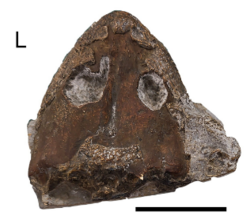Biology:Bothriceps
| Bothriceps Temporal range: Early Triassic
| |
|---|---|

| |
| Holotype skull of B. australis | |
| Scientific classification | |
| Domain: | Eukaryota |
| Kingdom: | Animalia |
| Phylum: | Chordata |
| Class: | Amphibia |
| Order: | †Temnospondyli |
| Suborder: | †Stereospondyli |
| Clade: | †Brachyopomorpha |
| Genus: | †Bothriceps Huxley, 1859 |
| Type species | |
| †Bothriceps australis Huxley, 1859
| |
Bothriceps is an extinct genus of stereospondyl temnospondyl. It is a member of the infraorder Trematosauria and is the most basal brachyopomorph known.[1] It is one of the only brachyopomorph that lies outside the superfamily Brachyopoidea, which includes the families Brachyopidae and Chigutisauridae. It shares several similarities to Keratobrachyops, another basal brachyopomorph, and may be closely related to or even synonymous with it.[1][2]
The genus was named in 1859 by Thomas Henry Huxley with the description of its type species B. australis from the Early Triassic Upper Parmeener Group of Tasmania, Australia .[3] It was originally assigned to the family Brachyopidae and was not reassigned to a more basal position until 2000, when the clade Brachyopomorpha was constructed to accommodate for it.[1] The genus Bothriceps once included several species, but the only species assigned to it now is the type. Bothriceps major, named in 1909, was reassigned to the family Rhytidosteidae as the type species the genus Trucheosaurus in 1998.[4][5] The brachyopid Platycepsion wilkinsoni (then referred to as Platyceps wilkinsoni) was reassigned to Bothriceps in 1890 and in 1969, but was placed back within the original genus in 1973.[6][7][8]
References
- ↑ 1.0 1.1 1.2 Warren, A.; Marsicano, C. (2000). "A phylogeny of the Brachyopoidea (Temnospondyli, Stereospondyli)". Journal of Vertebrate Paleontology 20 (3): 462–483. doi:10.1671/0272-4634(2000)020[0462:APOTBT2.0.CO;2].
- ↑ Damiani, R. J.; and Kitching; J. W. (2003). "A new brachyopid temnospondyl from the Cynognathus Assemblage Zone, Upper Beaufort Group, South Africa". Journal of Vertebrate Paleontology 23 (1): 67–78. doi:10.1671/0272-4634(2003)23[67:ANBTFT2.0.CO;2].
- ↑ Huxley, T. H. (1859). "On some amphibian and reptilian remains from South Africa and Australia". Proceedings of the Quarterly Journal of the Geological Society 15 (1–2): 642–649. doi:10.1144/GSL.JGS.1859.015.01-02.71. https://zenodo.org/record/2179085/files/article.pdf.
- ↑ Woodward, A. S. (1909). "On a new labyrinthodont from Oil Shale at Airly". Records of the Geological Survey of New South Wales 8: 317–319.
- ↑ Marsicano, C. A.; and Warren; A. A. (1998). "The first Paleozoic rhytidosteid record: Trucheosaurus major Watson 1956 from the Late Permian of Australia, and a reassessment of the Rhytidosteidae (Amphibia, Temnospondyli)". Bulletin of the British Museum (Natural History), Geology 54: 147–154.
- ↑ Lydekker, R. (1890). "Catalogue of the fossil Reptilia and Amphibia in the British Museum (Natural History)". British Museum (Natural History) London 4: 1–295.
- ↑ Welles, S. P.; Estes, R. (1969). "Hadrokkosaurus bradyi from the Upper Moenkopi Formation of Arizona with a review of brachyopid Labyrinthodonts". University of California Publications in Geological Sciences 84: 1–61.
- ↑ Shishkin, M. A. (1973). "The morphology of the early Amphibia and some problems of the lower tetrapod evolution". Trudy Paleontologicheskogo Instituta 137: 1–257.
Wikidata ☰ Q4948653 entry
 |

